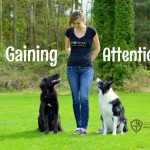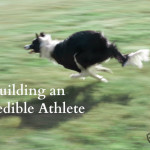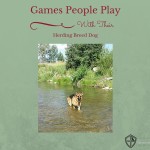3 Ways to Love Living with Your Active Herding Breed Dog
Is Living With An Active Herding Breed Frustrating?
Our herding breeds are naturally intelligent, agile, and active dogs with a lot of drive and stamina. These breeds were originally created for long days of hard work alongside humans. When not channeled appropriately, their drive and energy often contribute to hyper and destructive behaviors at home. Those behaviors make it difficult to express love towards our dog, but what does it really mean to love our dogs when their behavior can be the source of so much frustration? Let’s look at some ways we can channel their brains and bodies in order to get the most out of our relationships with our active canine companions.
Motivation & Rewards
Herding breeds tend to be toy- and food-driven. When a dog has “drive”, that means he has the desire and motivation to do something, or work to earn something. A “high-drive” dog will work hard and persist through physical and mental challenges for long periods of time. Dogs can have drive for many different things, including but not limited to: food/treats, toys, and games like tug or fetch.
A high-drive German Shepherd Dog or Collie should be able to settle down in the house, but in fairness to their breed as energetic and quick-witted dogs, you should enjoy finding proper outlets for their drive and reward them for channeling it into training and fun, rather than destructive behaviors at home.
Experiment with ways to motivate your dog by tapping into his drives. Some dogs always prefer to earn treats, while others prefer tugging on a braided rope. If your dog enjoys many types of rewards, change them up to keep things interesting and fun! For example, if your dog loves to earn treats at obedience class and also loves fetching tennis balls in your backyard, take your dog to the park and have him perform some of his obedience commands before you throw a tennis ball. Motivation for food treats and games with toys can be used in any number of formal activities (agility, flyball, tracking, competitive obedience, dock diving, etc), but also as a way to keep your dog’s drives satisfied at home.
Learning what motivates your dog opens up opportunities for the two of you to connect and have fun together. You will learn to speak your dog’s language, and your dog will bring more willingness to obey your instructions when there’s something fun in it for him.
Communication & Expectations
Dogs thrive on consistency and clear expectations. As alert, intelligent dogs, herding breeds are no exception. Allowing a young, energetic, driven dog free reign around the house may seem like an act of love, but it usually sets the dog up for failure if there aren’t some ground rules in place. While there may be some dogs that are naturally reliable around the house and never show any destructive behavior, with high-drive herding breed dogs, this is typically not the norm.
Sure, your dog will undoubtedly enjoy 24/7 freedom around your house, but how do you react when you come home and find the baseboards chewed and the couch cushion shredded? Should you be upset with your dog, or yourself? Dogs need you to set clear expectations so they can offer the behavior that earns rewards, and they will thrive where these expectations are consistently enforced. Herding dogs are problem solving animals that have a great aptitude for training and behavior modification. It’s up to you to help your dog learn the rules and expectations by limiting their access to resources they cannot be trusted with, and while rewarding them for appropriate behaviors around the house.
Communication Technique
A great technique for communicating clear expectations to your dog and setting him up for success is called “Nothing In Life Is Free” (abbreviated NILF or NILIF). To implement this technique, initially limit your dog’s freedom and access to desirable resources such as dog toys, furniture or dog beds, areas of the house or yard, opportunities to interact with new people and dogs, etc. Then, provide opportunities for your dog to earn these things over time. Below are some basic examples of NILIF:
When Greeting Guests, Your Dog is Overexuberant - Barking and Jumping Up
Confine the dog to a room out of the way (try a baby gate so he can still see and hear) and once your dog is calm, allow him out to meet your guests. You may want to have him on a leash at first, but if he remains calm and respectful of their space, you can remove the leash. If he barks or tries to jump on people, the privilege should be revoked and he should be returned to the confined space.
Your Dog is Pushy, Trying to Dash Out of the Door Once It’s Opened
Command your dog to perform a simple behavior he already knows, but that is incompatible with dashing out the door. For example, a dog that is doing a sit-stay or down-stay can’t run out the door. Allow him to go out the door once he demonstrates restraint. Be consistent and do this each time you are at the door, so that sitting or lying down calmly becomes his default behavior, rather than pushing past you out the door.
Your Dog Steals Food - Off Counters, Tables, Plates, or Will Beg
Use the same techniques described above for a dog who is overly excited meeting new people: physically limit your dog’s access to the counters or areas of the house where people are eating food. Allow your dog into areas with food, but only while you have control.
Have your dog perform some basic obedience skills that keep him out of your way and prevent him from jumping up and stealing food. For example, I have a young German Shepherd Dog that immediately goes into a down-stay when I’m eating a snack. If he’s pushy with me, he is removed from the room, but if he stays out of my way in a down-stay, he’ll earn a dog treat.
Note that there are some things in life that should always be freely given to our canine companions: warm and dry shelter, meals and water, and our attention and affection. Use NILIF to modify undesirable behaviors and shape your dog into a well-mannered home companion. When in doubt, seek the guidance of a certified professional or behaviorist.
Article By: Lies A. Rosema






